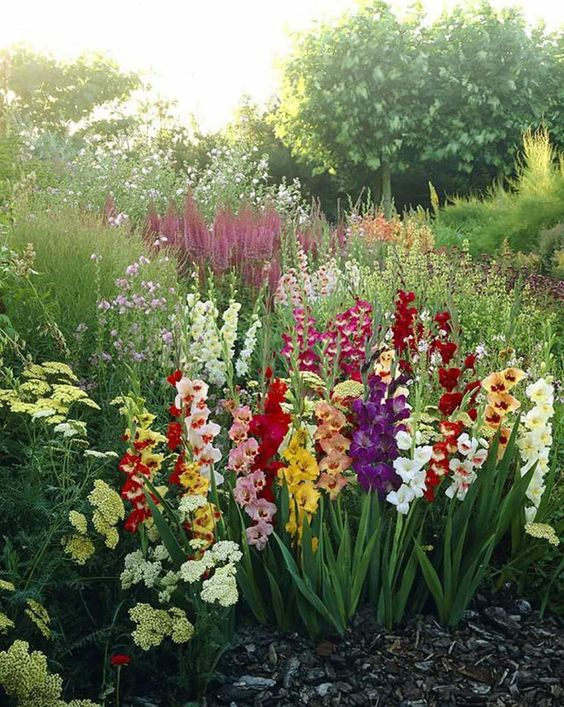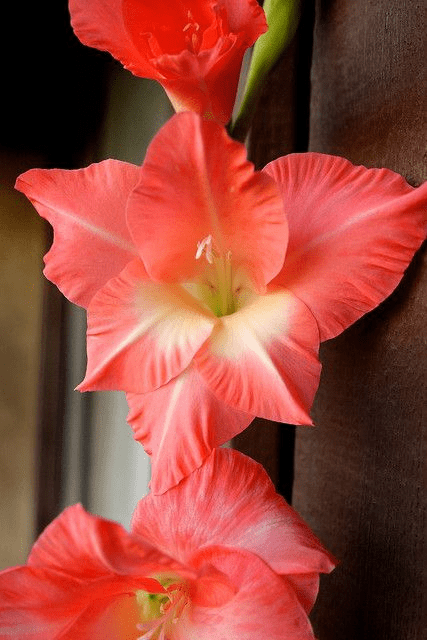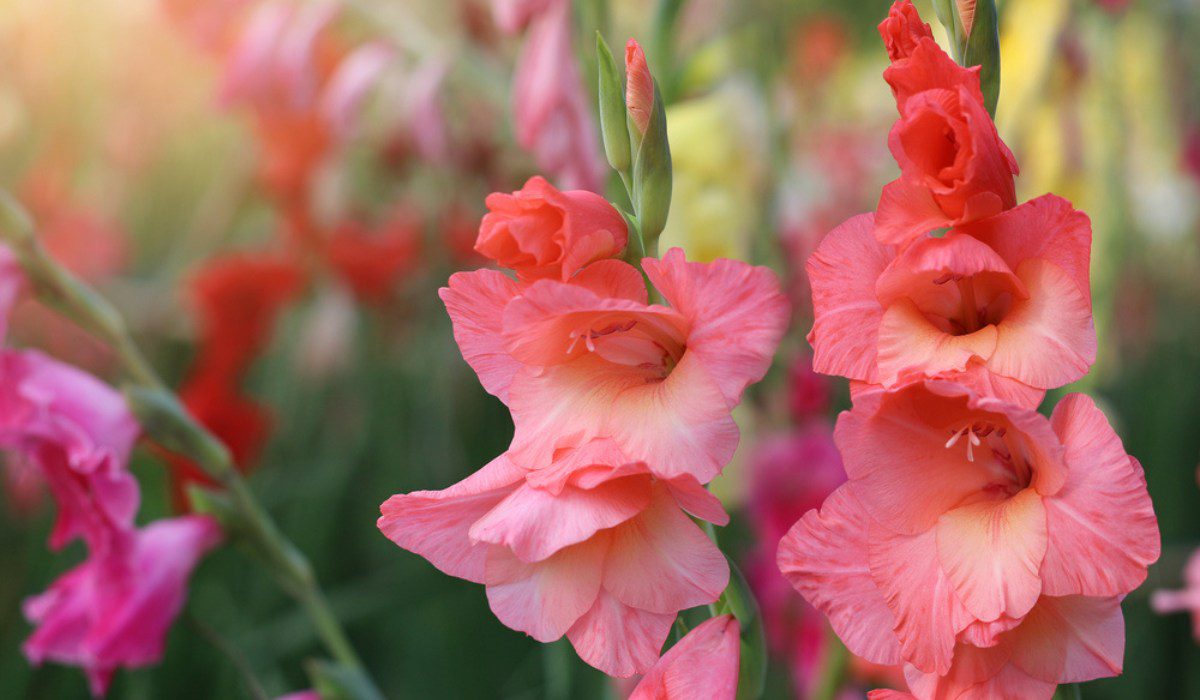Gladiolus has been a favourite of gardeners for generations. Summer blooming bulbs with orchid-like blooms produce elegant 3-foot flower spikes. They look beautiful in a vase and can be grown in flower gardens, container gardens, or even vegetable gardens. Read on to learn more about how to plant, grow and care for Gladiolus plants in your backyard.
What is Gladiolus plant?
Gladiolus is a genus of cormous perennial flowering plants in the iris family. It is sometimes referred to as the ‘sword lily,’ but it is more commonly known by its generic name (plural Gladioli).
Gladiolus flowers come in a variety of colours, including white, yellow, pink, and lavender, as well as rose, burgundy, purple, and even green. The bulbs are extremely simple to grow. Simply plant them in the spring for flowers in the late summer.
See also: What makes the sweet-smelling Frangipani a must-have garden plant?
Gladiolus: Quick facts
| Species name | Gladiolus |
| Family name | Iridaceae |
| Synonyms | Antholyza, Cunonia, Bertera, etc. |
| Height | 2-3 feet tall |
| Distribution range | Asia, Mediterranean Europe, South Africa, Tropical Africa |
| Uses | Gladioli is said to be antibacterial |
| Environmental impact | Positive |
| Maintenance | Low |
| Best season for growth | Summer |

Source: Pinterest
see also about: callistephus
Gladiolus varieties
‘Prins Claus’ Gladiolus flower
The magnificent pure white petals of the Gladiolus ‘Prins Claus’ flowers contain vivid fuchsia leaf-shaped patterns. The towering flower spikes of this hardy Gladiolus nanus hybrid, which can grow as tall as 3 feet (1 metre), bear the white blossoms.
‘Black Pearl’ Gladiolus flower
Gladiolus ‘Black Pearl’ flowers are dark burgundy red funnel-shaped flowers that grow abundantly on tall flower spikes. Flowering stalks, which may grow up to 4 feet (1.2 metres) tall, are perfect for Gladiolus flower arrangements and flower beds.
Flowers of Gladiolus Illyricus
Gladiolus illyricus, also known as the wild Gladiolus, has showy hooded magenta or dark lilac flowers with large petals. The whitish streaks on the lower petals of the pink-purple flowers help to identify this dwarf Gladiolus species.
‘Star of Bethlehem’ Gladiolus flower
The snowy-white blooms of Gladiolus ‘Star of Bethlehem’ have large wavy petals and a contrasting pink or lilac throat. The white Gladiolus flowers grow in abundance on straight, erect flower stalks.
‘Alatus Flipphi’ Gladiolus flower
The gladiolus ‘Alatus Flipphi’ has flowers that are hooded, deep orange and yellow, with triangular top petals and linear lower petals. Pure orange petals on the gorgeous blooms contrast with lower yellow petals with orange ends.
‘Red Sword Lily’ Gladiolus flower
Bright red tubular flowers that are numerous on each stem can be found on gladiolus ‘Red Sword Lily’ blossoms. The Grandiflora hybrid’s beautiful red Gladiolus flowers unfurl, revealing frilly petals that create impressive colourful blooms.
Gladiolus ‘Byzantinus’ flower
Gladiolus ‘Byzantinus’ flowers are beautiful magenta-coloured funnel-shaped flowers that grow to be 2″ (5 cm) wide. Each flowering stem is erect and contains up to 15 vibrantly coloured dark pink blooms.
Priscilla Gladiolus flower
Gladiolus ‘Priscilla’ flowers have eye-catching multi-coloured blooms of light yellow, pink, and white. The eye-catching ruffled blossoms grow in profusion on flowering stems that have over 12 flowers per stem.
‘Gartengladiole Apricot’ Gladiolus flower
Gladiolus ‘Gartengladiole Apricot’ flowers provide lovely yellow and orange blossoms throughout the summer. Large apricot-coloured flowers with slightly ruffled petals grow in a funnel shape on this tall Gladiolus variety.
‘Carmineus’ Gladiolus flower
Gladiolus ‘Carmineus’ has dark pink trumpet-like flowers with a star shape that bloom in groups on thin stalks. In the late summer and early fall, gladiolus blossom. The eye-catching plant is one of the dwarf kinds of Gladiolus, growing to a height of between 12″ and 20″ (30–50 cm).
Gladiolus: When to plant?
It’s advisable to start planting Gladiolus corms in the spring after the frost has passed and the soil has warmed to at least 13°C. Plant another round of Gladiolus corms every 10 days between last frost date and early summer. This will lead to continuous blooms till early fall. Based on the variety of Gladiolus you want to grow, it can take anywhere from 60 to 90 days for the corms to grow roots and bloom.
Gladiolus: How to plant?
- Prepare your garden by loosening the soil 12 to 15 inches deep with a garden fork or tiller. After aerating the soil, add a 2- to 4-inch layer of aged manure or compost.
- Plant corms that are 114 inches or larger in diameter to ensure large blooms.
- Place the corm in the hole, pointed end up, about 4 inches deep. Cover with soil and firmly press.
- Corms should be spaced 6 to 8 inches apart.
- Plant Gladioli in rows if you want to use them as cut flowers. It is simpler to care for the plants and harvest the flowers.
- For the greatest results, place the corms in borders or annual beds in groupings of seven or more other flowers.
- When planting, thoroughly water the corms.
- If you’re planting tall varieties, stake them before planting. Take care not to harm the corms with the stakes.
Gladiolus: How to grow?
Follow the steps given below to grow Gladiolus plants in your garden:
- Apply a 2-4 inch deep layer of mulch around your plants to keep the soil moist and prevent weeds.
- If you receive less than 1 inch of rainfall a week, make sure to water the plants regularly all through the summers. Else, water them moderately during the growth phase to keep the soil moist.
- Remove the dead and faded flowers to ensure consistent blooms. If all the flowers on a stalk die, cut off that stalk at around 2-3 inches above the soil.
- Make sure to leave your plant intact to help it mature and grow blooms during the next season.

Source: Pinterest
Gladiolus: Care tips
Gladiolus: Sunlight requirements
Gladiolus prefers full sun, but if that is not available, they will flower in partial shade.
Gladiolus: Soil requirements
Gladiolus bulbs can be grown in any well-draining soil. Although glads can tolerate shallow planting, planting them at least 6 inches below the soil’s surface gives emerging shoots support.
Gladiolus: Water requirements
Water thoroughly after the initial planting. Then, water Gladiolus once a week.
Gladiolus: Humidity and temperature requirements
Planting Gladioli too early will not result in earlier blooms; Gladioli will pout and even rot in cold soil. Before planting Gladiolus bulbs in your yard, wait until the nighttime lows hit 60 degrees Fahrenheit. Also, pick a spot where there will be at least five hours of direct sunlight every day. Up until the first frost, gladioli bloom. The blooming season can be extended by planting fresh corms every two weeks because the plants don’t bloom all the time.
Gladiolus: Fertiliser requirements
Apply a balanced, 10-10-10 liquid fertiliser to newly emerged Gladioli shoots.
Gladiolus: Pruning
After the flowers have withered, pinch them back. When the plant has finished blooming, cut the bloom back to ground level with gardening shears unless you intend to dig and store your bulbs.
Gladiolus: Overwintering
Gladiolus flowers may be perennial in zones 8 and higher, but most gardeners consider them annuals. When the first frost arrives, dig up your glad bulbs for winter storage. Prior to keeping them in a cool, dry location, let them dry out for a few weeks.
Gladiolus: Pests and diseases
Thrips can be a nuisance to Gladiolus plants. The tiny winged insects may not be visible, but you will notice brown foliage tips and flecked foliage. Thrips can be treated with insect soap.
Gladiolus: Uses
As a cut flower
Gladiolus is a beautiful cut flower that is in high demand in the international market due to its long vase life, attractive colours, and year-round availability. The flower typically lasts 6 to 10 days in a vase, but treatment with appropriate preservatives extends the life as well as the market price of flowers.
As an antimicrobial agent
Corms are also used to treat infections. Corm extract has antimicrobial properties and aids in the recovery of various urogenital and gastrointestinal issues.
As food
Corms are consumed as edible food by people in some African countries.
Cormels and corms
Corms and cormels are flower propagation materials that are both underground stems. When the plant has completed its life cycle, the underground stems are dug out of the soil, packed, and sold in the market using proper post-harvest practices. Selling corms and cormels is one way to generate income. This propagating material can be saved for future planting.
Other applications
Gladiolus corms are used to treat diarrhoea, coughs and colds, dysentery, and constipation in African countries. In China, flowers are also used in ceremonies and funerals.
FAQs
What are some of the most common Gladiolus diseases?
Even though glads can usually withstand harsh sunlight, there are some environmental factors that could limit their growth. Aster yellows, viruses, and botrytis are common pests attracted to these plants.
Is Gladiolus poisonous or not?
Gladiolus corms may cause mild stomach upset in humans. Animals and pets may experience nausea, diarrhoea, excessive salivation, and lethargy. If the animals in your care have eaten corms, contact your veterinarian right away.
How do you take care of gladiolus throughout the winter?
Winter care for Gladiolus bulbs is climate-dependent. In colder climates, the bulbs must be lifted from the ground and dried for winter storage in a cool, dark place.






